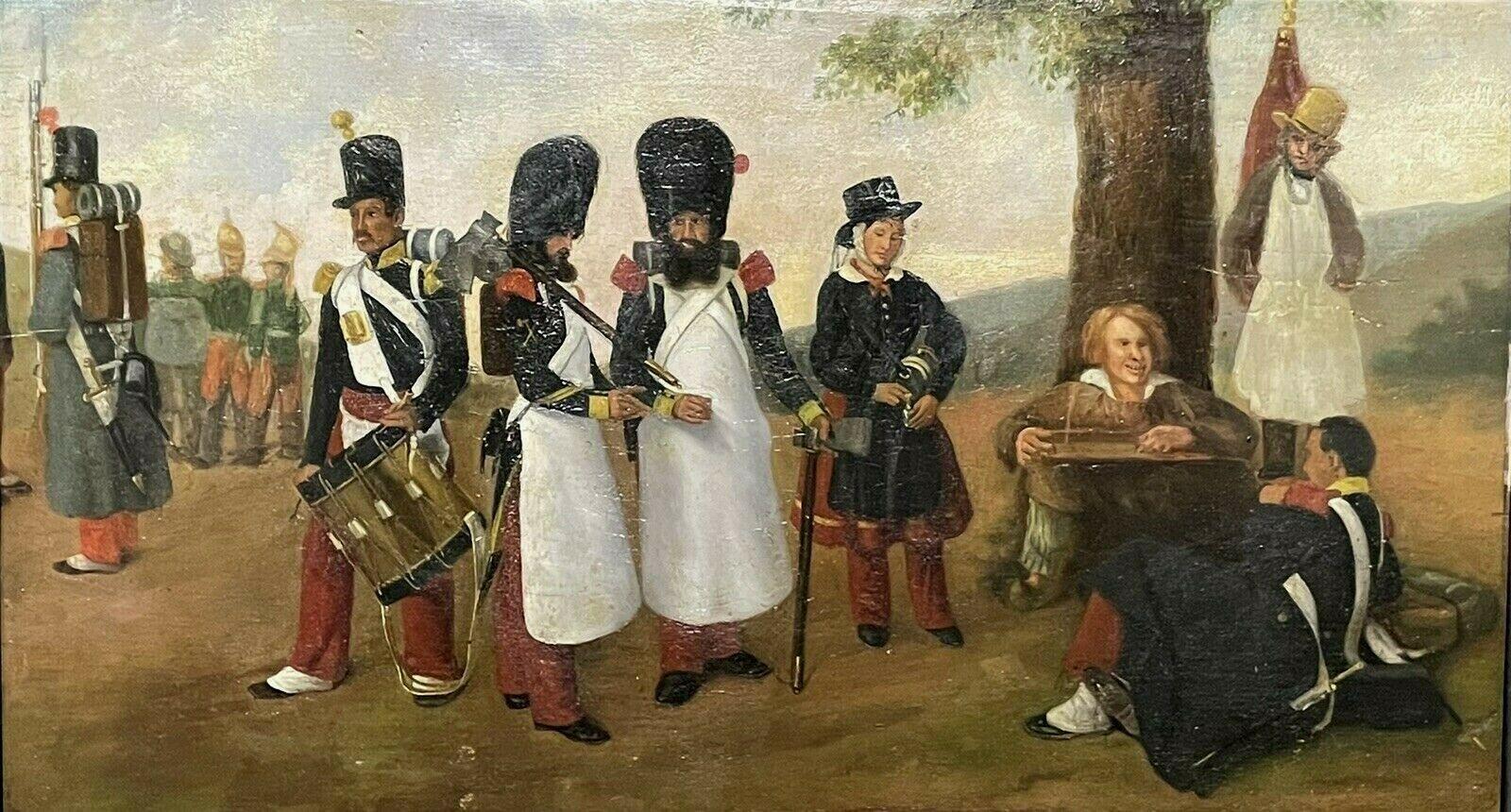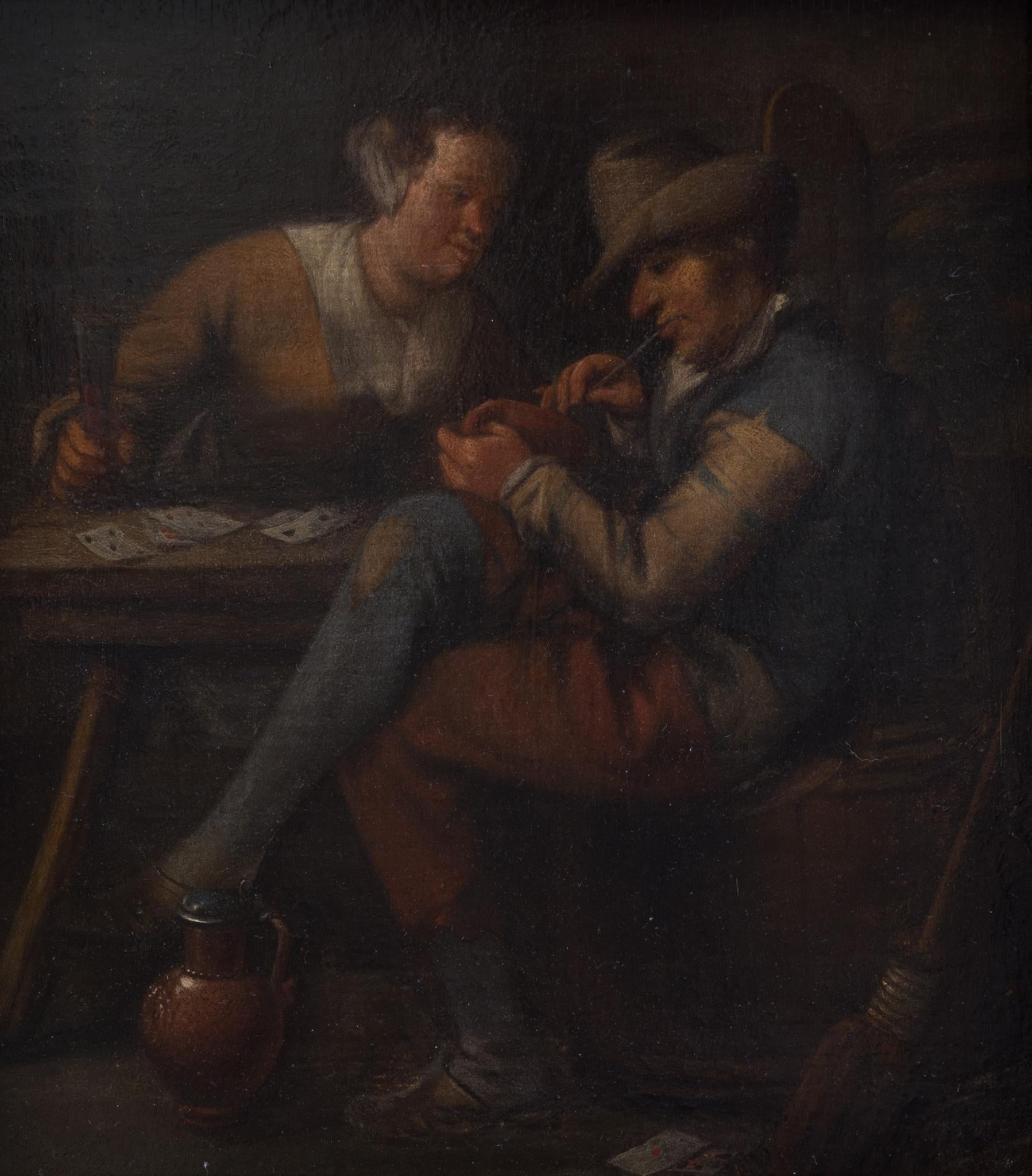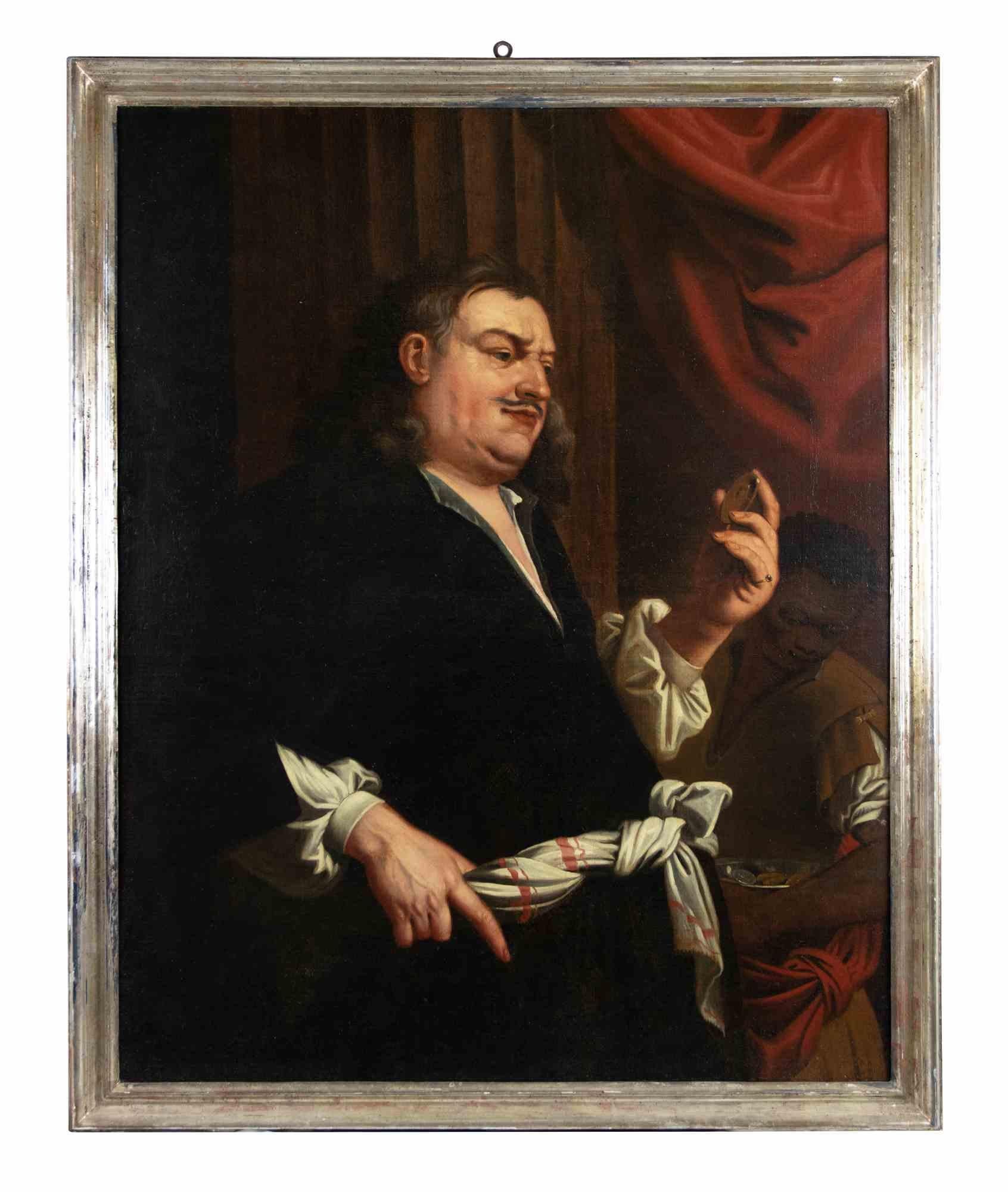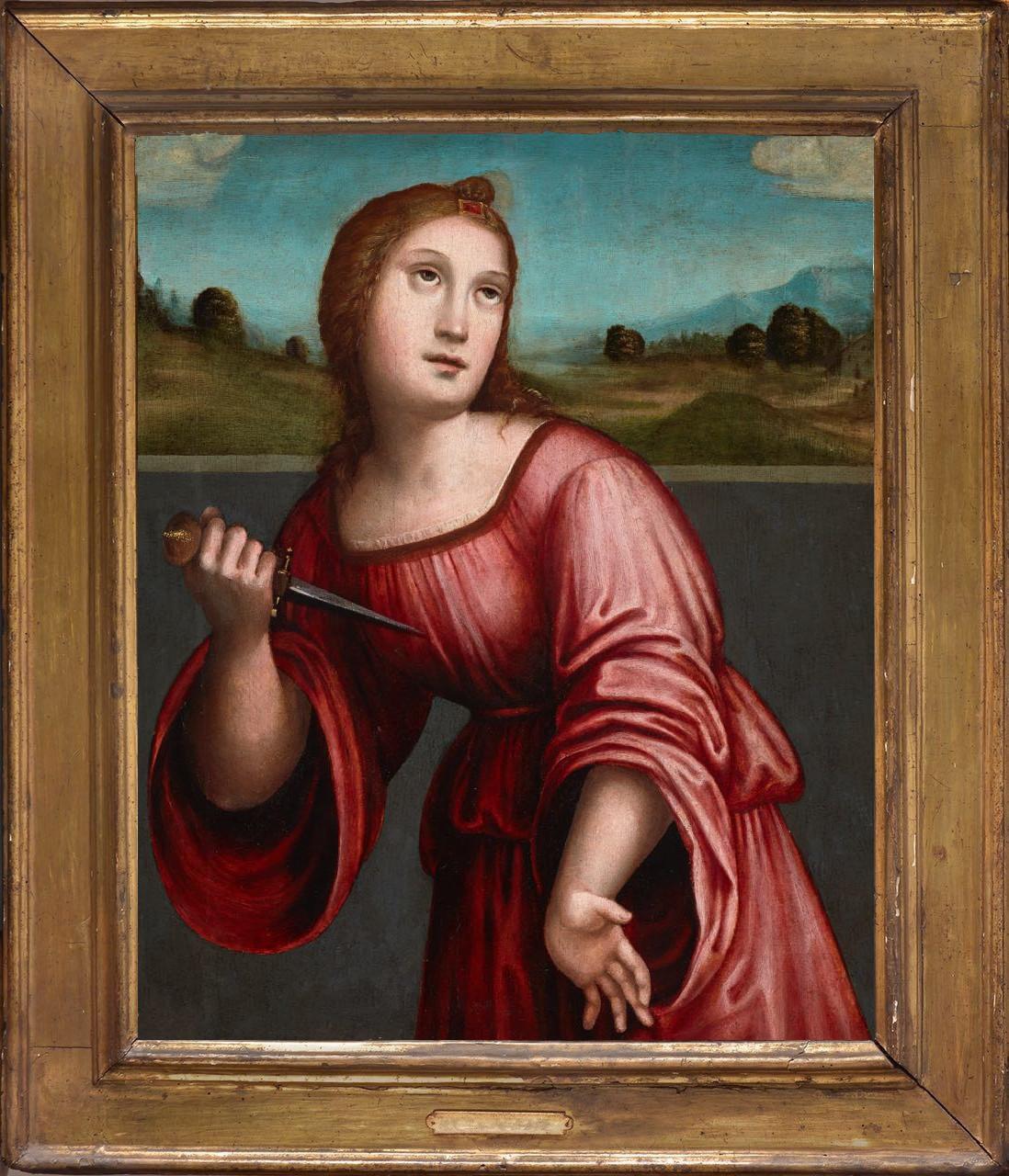Items Similar to 17th century German portrait of a man - Wine merchant Caspar Roemerskirchen 1628
Want more images or videos?
Request additional images or videos from the seller
1 of 14
17th century German portrait of a man - Wine merchant Caspar Roemerskirchen 16281628
1628
About the Item
17th century German portrait of the wine merchant Caspar Roemerskirchen at the age of 26 in 1628, attributed to Gottfried de Wedig
This highly decorative portrait depicts the 26 year old Caspar Roemerskirchen, wearing an intricate jacket made of a luxurious black fabric, which is stiffened and shaped to perfectly fit his silhouette. It is adorned with an opulent collar, which at the time was a true status symbol, worn to emphasise the refined class and social status of the sitter. In his hands he is holding luxurious soft leather gloves. The vivid green drapery and table cloth add further vivacity to the portrait. His ice blue eyes appear to be shimmering with a life-like quality.
Gottfried de Wedig (also known as Gotthardt) was a German painter born in 1583 in Cologne. His grandfather was the celebrated artist Barthel Bruyn the Younger, who probably taught him to paint. Gottfried is particularly remembered for portraits and still-lifes. De Wedig's portraits of the upper class in Cologne offer valuable glimpses into the social fabric and cultural ambiance of the period. By immortalizing notable figures, De Wedig not only preserved their identities but also recorded the prevailing power dynamics and societal norms. In addition to their aesthetic value, his portraits also serve as historical artifacts, providing insights into the fashion, lifestyle, and aspirations of his sitters. Beyond their documentary value, Wedig's legacy resonates through his artistic mastery and his ability to capture emotion endow his portraits with a timeless allure. The paintings transcend mere representation; they serve as windows to a bygone era, offering enduring reflections on the human condition and the transformative power of art across time.
His works have been included in notable museums and collections including in: Louvre (Paris), Wallraf-Richartz-Museum (Cologne) and the Kölnisches Stadtmuseum (Cologne).
Measurements: The board measures ca. 97 by 75 cms and with frame ca. 115 by 93 cms.
Provenance: Private collection Germany (as Franz Kessler)
Selected literature on the artist:
H. Vey, 'Nochmals Gottfried von Wedig, Auguste Braun und Everhard Jabach', Wallraf-Richartz-Jahrbuch 35 (1973), p. 261-280
H. Vey, 'Gottfried von Wedig', Wallraf-Richartz-Jahrbuch 24 (1962), p. 295-320
M. Spies, 'Neue Erkenntnisse zu Gottfried von Wedigs Bildnis der Magdalena Stroe (1631)', Wallraf-Richartz-Jahrbuch 70 (2009), p. 305-308
H. Vey, 'Neues zu Augustin Braun und einige Kölner Zeitgenossen', Wallraf-Richartz-Jahrbuch 51 (1990), p. 295-320
- Attributed to:Gottfried De Wedig (1583 - 1641, German)
- Creation Year:1628
- Dimensions:Height: 37.8 in (96 cm)Width: 29.53 in (75 cm)
- Medium:
- Movement & Style:
- Period:
- Condition:Lovely and ready to hang. Cleaned in 2024, some scattered inpainting visible under uv-light. Light age-related wear to the frame.
- Gallery Location:Antwerp, BE
- Reference Number:1stDibs: LU1423213917832
About the Seller
5.0
Gold Seller
These expertly vetted sellers are highly rated and consistently exceed customer expectations.
Established in 2020
1stDibs seller since 2020
353 sales on 1stDibs
Typical response time: 4 hours
- ShippingRetrieving quote...Ships From: Antwerp, Belgium
- Return PolicyA return for this item may be initiated within 2 days of delivery.
More From This SellerView All
- 16th century old master painting of a Nun - Queen Jeanne de FranceLocated in Antwerp, BEVery fine 16th century French or Flemish Old Master portrait painting of a nun The present painting has been very delicately painted by an accomplis...Category
16th Century Old Masters Portrait Paintings
MaterialsOil, Panel
- Large 17th century Flemish old master painting - Diana and Callisto - RubensLocated in Antwerp, BE17th century Flemish Old master painting "Diana and Callisto" attributed to Victor Wolfvoet the Younger Our painting is based on Rubens' great work of...Category
17th Century Old Masters Figurative Paintings
MaterialsCopper
- 17th century Flemish Old master - Silenus feasting - Wine GodLocated in Antwerp, BE17th century old master painting "Silenus feasting", likely studio of Sir Anthony Van Dyck Born in Antwerp in 1599, Anthony Van Dyck entered the studio of Rubens (1577 - 1640) at the age of nineteen. Quickly, the master perceives the talents of the young prodigy and makes him his first assistant. Van Dyck, for his part, has a particular admiration for the man whose name is known throughout Europe. In 1619, he was inspired by a drunken Silenus by Rubens, produced one or two years earlier for a composition on the eponymous theme. This work, now in the Dresden Museum, appears to be the first version of our painting. That work has an illustrious provenance; it was recorded in the private collection of Leopold Wilhelm (Archduke of Austria) in 1662, in 1722 it was bought by the famous German painter Antoine Pesne for the King of Saxony in Dresden (Staatliche Kunstsammlungen Dresden - Gemäldegalerie Alte Meister, Dresden, inventory number 1017). From 1945 until 1955 it was on display at the Pushkin Museum in Moskou, after having been taken by Russia after the Second World War. It was then returned to the Staatliche Kunstsammlungen Dresden where it is still on display. Our painting is of a fine quality and has been painted by a skilled and confident hand. It displays some slight variations in the composition when compared to the original; the legs of Silenus are smoother and less hairy, more humanoid than satyresque. There might also be a pentimento visible at the level of the legs where one observes traces of hair on and under the material. This area can be compared to that of a canvas by Van Dyck kept in Brussels, of a still drunk Silenus whose animal legs are formally treated in the same way as the ones in our composition. Furthermore, the skirt of the figure to the far left has a purplish-red colour in our work, whereas in the first version it appears to be white. There also appear to be differences in the sky, firstly the clouds are shaped slightly different, the sky in our painting has a more vivid colour and there is also a golden hue of a sunset visible to the far left. This treatment of the background appears close to that of a Saint Rosalie, now kept at the Metropolitan Museum in New York and dated 1625, which might offer a reference for dating our painting. In the evanescent aspect, as non finito of its figures, it is interesting to compare our Silenus to a Saint Sebastian, conserved in the Escorial Museum in Madrid. Also, the theme remains rather curious. According to Barnes and Porter, Rubens, like Van Dyck after him, was partly inspired by Book XI of Ovid's Metamorphoses, but a second literary or pictorial source remains unknown (1). For the original composition, Stephan Maaser, art historian, establishes a correspondence between the position of Silenus, referring to that of a Christ at the moment of the Lamentation or the Descent from the Cross (2); the female characters on the left and the male on the right refer more to Mary Magdalene and Saint John than to the Phrygians or the members of a bacchanalian procession. Finally, note that Silenus is not usually a faun. The success of the composition at the time of its public reception and its engraving by Franciscus van der Steen really contributed to the dissemination of the work. At the same time, it testifies to the intense activity of the painter and his studio in Antwerp, before he left to work at the English court. About Silenus: In greek mythology, Silenus was the tutor and foster-father of the wine god Dionysos, who was entrusted to his care by Hermes after his birth from the thigh of Zeus. The young god was raised by Silenus and nursed by the Nysiad nymphs in a cave on Mount Nysa. Silenus was, in essence, the spirit of the treading dance of the wine-press, his name being derived from the words seiô, "to move to and fro," and lênos, "the wine-trough." Once, when Dionysos was travelling through Phrygia, Seilenos became lost and was captured by King Midas. The king treated him hospitably and as a reward Dionysos granted him his golden touch. The artists biography: Born in Antwerp on 22 March 1599, Anthony van Dyck was the seventh child of Frans van Dyck, a wealthy silk merchant, and Maria Cuypers, who was renowned for her embroidery skills. In 1609, when he was ten years old, his parents apprenticed the precocious youth to Hendrik van Balen (1575-1632), a painter of small cabinet pictures and dean of the city's Saint Luke's Guild. Although the length of Van Dyck's stay with Van Balen is not known, it probably lasted three to four years. Van Dyck registered as a master in the Antwerp Saint Luke's Guild on 11 February 1618, by which time he was already in demand as a portrait painter (see the NGA painting, Portrait of a Flemish Lady...Category
17th Century Old Masters Figurative Paintings
MaterialsOil, Canvas
- 17th century Old Master painting - Allegory of Justice - truth demons skeletonLocated in Antwerp, BELate 17th, early 18th century old master oil painting depicting an allegory of Lady Justice holding demons at bay Our painting, likely a sketch for a much larger work,, conveys a pr...Category
18th Century Old Masters Figurative Paintings
MaterialsCanvas, Oil
- 18th century French Rococo Portrait painting of a noble lady - young ladyLocated in Antwerp, BE18th century French Rococo portrait of a young noble lady This cheerful young lady is looking at the spectator with a sparkling eyes has a cheeky smile on her face, almost as if she has just heard a funny story. She is very elegantly dressed, wearing a blue dress with embroidered silk sleeves. The bodice is adorned with a cream silk band which has been beautifully tied to a ribbon at the top, a tulle-lining completes the dress. Her hair is styled in an elaborate 18th century style and tied together with a blue and cream silk hairband. This portrait has been wonderfully painted, the artist not only beautifully depicted the fabrics, but also marvellously captured the happy nature of the sitter. The painting really has a soul, when one looks at it, it feels as if one is looking at a real person. It is very close to the works of Joseph-Siffred Duplessis (1725-1802) and it shares an uncanny resemblance to the portrait that he painted of the Comtesse de Provence, Princess of Savoie and wife of the King Louis XVIII of France. Duplessis is known to have reused many of his favoured compositions in different portraits, but he always applied slight differences, such as in the present painting. We believe that the present painting was created by someone from his very close circle. Joseph-Siffred Duplessis (1725-1802) was a renowned French portrait painter, famed for his intimately rendered portraits. After training for many years in Paris, Duplessis presented himself to the Académie in 1769 and was afforded the opportunity to exhibit regularly at the Salon. He was very successful and in 1777, he was allowed to paint a full-length portrait of Louis XVI (1754–1793) in his state robes. Two years later he created a portrait of Benjamin Franklin in a red coat with a fur collar, a painting which was the subject of much favorable comment. It was destined to become the artist’s most famous work and perhaps the best known image of the great American patriot...Category
18th Century Old Masters Portrait Paintings
MaterialsCanvas, Oil
- 17th century Allegory of the four Elements - Frans Francken the Younger FlemishBy Frans Francken IILocated in Antwerp, BEVery fine 17th century Flemish old master "Allegory of the four elements" attributed to Frans Francken the Younger The figures are the Nereid Amphitrite, holding a coral and represe...Category
17th Century Old Masters Figurative Paintings
MaterialsOil, Panel
You May Also Like
- 17thC Spanish Colonial School Frame with orig. Painting St. Joseph Jesus ChildBy Spanish Colonial (Peruvian)Located in Meinisberg, CH17th Century Spanish Colonial School (Likely to be School of Cuzco in Peru) - St. Joseph with the Christ Child carrying a basket, housed in its original carved, hardwood frame. • Painted in oil on canvas (laid on to fiberboard), ca.58 x 48 cm • Original frame, ca. 64 x 54 cm • Visible image ca. 52.5 x 42.5 cm Centuries ago this religious painting, depicting St. Joseph with his flowering staff and the Christ Child carrying a basket, was originally displayed in a church or chapel in 17th Century colonial...Category
17th Century Old Masters Figurative Paintings
MaterialsGold Leaf
- 19th CENTURY FRENCH ANTIQUE OIL ON PANEL - FRENCH SOLDIERS MAKING CAMPLocated in Cirencester, GloucestershireArtist/ School: French School, 19th century Title: The Soldiers Camp Medium: oil painting on thick wooden panel, with a bevel edge Size: painting: 12.5 x 22 inches, frame: 16.5 ...Category
19th Century Old Masters Figurative Paintings
MaterialsWood, Oil
- The Card Players by a Flemish 1600s ArtistBy Flemish School, 17th CenturyLocated in Stockholm, SEFlemish 1600s School The Card Players oil on oak panel panel dimensions 22.5 x 20 cm frame included Provenance: From a Swedish private collection. Condition: Flat and stabl...Category
17th Century Old Masters Figurative Paintings
MaterialsOak, Oil, Panel
- A Rich Merchant - Painting by Unknown - 18th CenturyLocated in Roma, ITA rich merchant is an original old master artwork realized in the 18th Century. Mixed colored oil painting on canvas depicting a merchant looking at a coin in his left hand. Provena...Category
18th Century Old Masters Figurative Paintings
MaterialsOil
- Lucretia, by Giacomo Raibolini Francia. Detto il Francia. Oil on panel, framedLocated in Brooklyn, NYGiacomo used to paint with his brother Giulio, identifying their works with the monogram «I I». The strong influence of his father, Francesco, is undeniable in all his works, althoug...Category
16th Century Old Masters Figurative Paintings
MaterialsOil, Wood Panel
- Portrait of Jean-Baptiste Greuze, painted on linen by his daughter Anna GreuzeLocated in PARIS, FRThis replica of the last self-portrait of Jean-Baptiste Greuze painted in 1804, executed by his daughter Anna at her father's side and recently rediscovered, provides us with a poignant image of the great artist, represented with panache despite the disillusions of life. 1. Jean-Baptiste Greuze Jean-Baptiste Greuze was the sixth child of a roofer from Tournus and retained a certain rusticity in his behaviour from his provincial childhood, beyond his taste for describing picturesque scenes of the countryside. He initially started training with a little-known painter from Lyon, Charles Grandon, before his genius was recognised in Paris where he became a full-time student of the Académie (of Painting) in 1755. He exhibited his work for the first time at the Salon during the summer of 1755, before leaving on a trip to Italy in the company of Louis Gougenot, abbot of Chezal-Benoît. Upon his return to Paris, Greuze became a prolific painter, participating widely in the Salons held between 1759 and 1765, to which he sent no less than 63 paintings: numerous genre scenes (The Marriage Contract, The Beloved Mother), but also portraits of his family circle, of courtiers and art lovers, or of his colleagues. The Academy closed the doors of the Salons to him in 1767 for not having produced his reception piece within six months of his reception, as was the tradition. He worked actively on this painting (Emperor Severus rebukes Caracalla, his son, for trying to assassinate him ) until the summer of 1769, tackling historical and mythological subjects for the first time. Once this was completed, he was then fully admitted to the Academy, but as a genre painter, and not as an historical painter, which had been one of the greatest humiliations of his life. Greuze then refused any participation in events organised by the Academy or its successor, the Academy of Fine Arts until 1800. Abandoning history painting, he gave a new twist to genre scenes, bringing them closer to history painting, as in this pair of canvases which constitutes some of his masterpieces: The Paternal Curse: The Ungrateful Son and The Paternal Curse: The Punished Son . Married in 1759 to Anne-Gabrielle Babuti, the daughter of a Parisian bookseller, his marriage was unhappy and his wife probably frequently unfaithful. The institution of divorce enabled him to record their separation in 1793, keeping his two daughters Anna-Geneviève, born in April 1762, and Louise-Gabrielle, born in May 1764, with him. Little is known about his daughter Anna except that she was herself a painter and lived with her father until his death. It is likely that most of the paintings she produced up to that date were attributed to her father, whose technique she shared to a great extent, making it extremely difficult to establish an autonomous corpus of her paintings. Greuze died in his studio at the Louvre on March 21st 1805. The attention paid to the expressivity of his characters and the emotional charge they convey enabled Jean-Baptiste Greuze to enjoy immense popularity with the eighteenth-century public, and they still constitute Greuze's true modernity. As the artist said, "I dipped my brush in my heart". Greuze was also an exceptional draughtsman and a portraitist of immense talent and exceptional longevity who painted both the Dauphin (the son of Louis XV and father to Louis XVI) and the young Napoleon Bonaparte. 2. Greuze's self-portraits Greuze was very much influenced by Dutch paintings during all his life. While the source of his inspiration for genre scenes can be found in Gerard Dou...Category
Early 1800s Old Masters Portrait Paintings
MaterialsLinen, Oil
Recently Viewed
View AllMore Ways To Browse
Portrait Of Black Man
Portrait Of A Black Man
Eyes Of Man
German Old Masters
Status Condition
Portrait Of An Old Man
17th Century German
Silhouette Portrait
Antique Silhouette Art
Antique Green Man
Old Antique Windows
German Artifacts
German Art And Artifacts
Antique Silhouette Frames
Portrait On Leather
German Antique Board
Antique Framed Silhouette
Antique Framed Silhouettes





